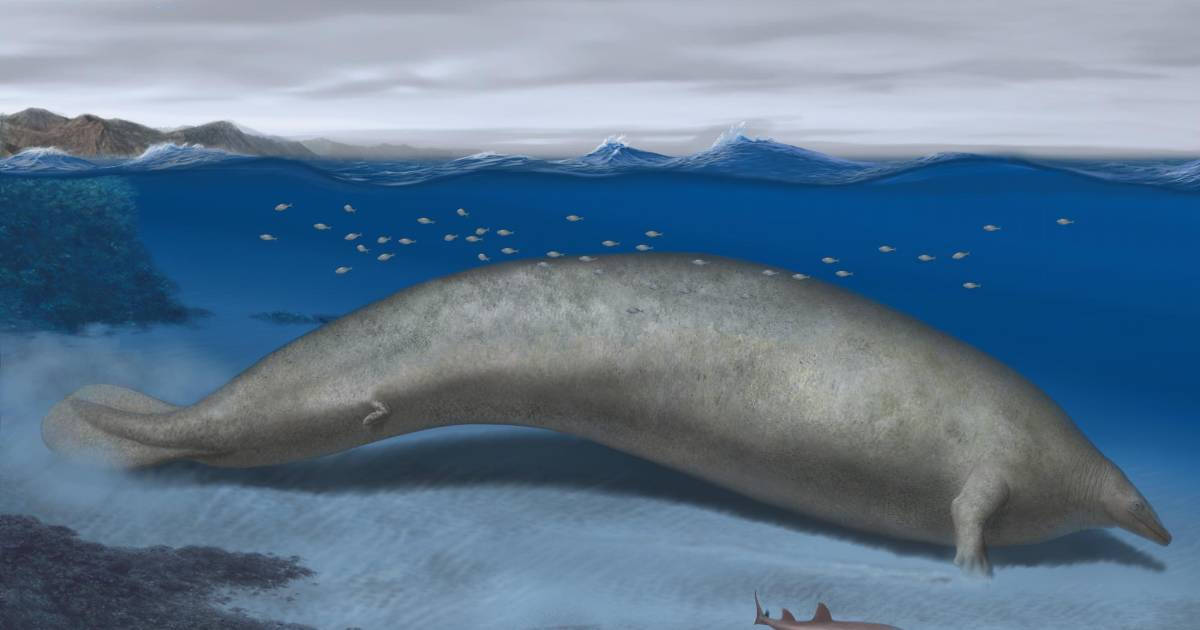Peru.
The Paleontologists The fossilized bones of one of the strangest whales in history were presented last week. This 39-million-year-old Leviathan, called PerucetusWeighing perhaps 200 tons, the blue whale is the largest known animal to date.
Although blue whales are graceful and fast divers, Perucetus is a very different animal. Investigators suspect it was lazily navigating the shallow coastal waters mammoth manatee, Propelling its sausage-like body with a fin-shaped tail.
Some experts cautioned that more bones need to be found before Perucetus’ weight can be firmly estimated. But they all agreed that the strange discovery could change the way paleontologists look at the evolution of whales since ancient times. Terrestrial mammals.
“This is a really amazing and rare fossil,” said Nicholas Pionson. Smithsonian National Museum of Natural History, who did not participate in the study. “This discovery makes it clear that there are many more ways to be a whale that we haven’t discovered yet.”
Mario Urbina, a paleontologist at the Museo de Historia Natural de la Universidad Nacional Mayor de San Marcos in Lima, Peru, first saw Perucetus in 2010. He was walking through the Atacama Desert in southern Peru when he saw a rock outcropping. Sand. When he and his colleagues finished excavating it, the lump turned out to be a gigantic spine.
Upon further excavation, the researchers found a total of 13 vertebrae, along with four ribs and part of a pelvis. Except for the pelvis, all the fossils were so dense and strangely thick that it was difficult to make out what kind of animal they belonged to.
Only the hips revealed what the scientists had discovered. Unlike the other bones, the pelvis was small and delicate. It had crests and other distinctive features that suggested it came from a whale, particularly an early branch of the cetacean evolutionary tree.
The Whales evolved From dog-sized land mammals about 50 million years ago. Some early species had short legs and probably lived like seals, hunting fish and crawling ashore to breed.
These first whales disappeared after a few million years. They were replaced by a group of entirely aquatic whales Basilosaurids. These elusive animals can grow as large as a school bus, but retain vestiges of their terrestrial life, such as tiny hind feet with toes.
Basilosaurids dominated the oceans until about 35 million years ago. When they died out, another group of whales arose that gave rise to the ancestors of today’s whales.
Today’s largest whales, such as the blue whale and the fin whale, reached their gigantic size only in the last few million years. Changes in ocean currents supported vast populations of krill and other invertebrates near the poles. The whales quickly sank and took this prey and grew in size.
Perucetus’ pelvis revealed that it was a basilosaurid, but the whale had evolved into a basilosaurid unlike anything found to date. Eli Amson, a bone tissue expert at the Natural History Museum in Stuttgart, Germany, discovered that her ribs and vertebrae had extra layers of outer bone, giving them bulging shapes.
A typical bone is filled with pores, making it lighter without sacrificing its strength. Amson observed that the bones of Perucetus were solid throughout. The fossil is so hard in places that it is impossible to hammer a nail into it.
“It will create sparks,” he said. Amsan and his colleagues scanned the fossilized bones in 3D to reconstruct the whale’s complete skeleton. They compared Perucetus to other basilosaurids preserved from head to tail.
If they were a thicker, denser version of the rest of the Perucetus whales, their entire skeleton would have weighed between 5.8 and 8.3 tons. That means Perucetus had a skeleton unlike any other mammal: bones weighing twice as much as a blue whale.
That bulky skeleton suggests Perucetus had a barrel-thick body. Although Perucetus was only about two-thirds the length of a blue whale, Amsan and his colleagues doubted its weight.
“It’s definitely on the range “Blue Whales”Amson said. Bienson believes it is premature to make such an assessment. “Until we find the rest of the skeleton, I think the heavyweight question should be shelved,” he said.
But paleontologist Hans Thevisen of Northeast Ohio Medical University, who was not involved in the study, said the estimate is reasonable. “I agree with the excitement around weight,” he said.
The fossil suggests that Perucetus reached large sizes without feeding like blue whales. Analysis of its bones suggests it lived like a giant manatee.
Manatees feed on seagrass on the ocean floor. Your lungs are filled with air and your intestines produce gas by fermenting your food. To stay underwater, manatees have developed dense bones that act as counterweights.
system Spine of Perucetus It is like a skull. Amson imagined the whale slowly raising and lowering its tail swimming manatee-style.
Based on the rocks where the fossils were found, Amson and his colleagues suspect that Perucetus moved slowly in coastal waters shallower than 150 feet. But how they fueled their gigantic bodies remains a mystery.
Regardless of how it managed to survive, Perucetus is proof that whales didn’t have to wait until recently to become huge. “The most important message is not that we can get into the Guinness Book,” Amson said. “It’s another path to greatness.”



:quality(85)/cloudfront-us-east-1.images.arcpublishing.com/infobae/DYRQWUXU2VHMHNIVOD22JCU2KU.jpg)
:quality(85)/cloudfront-us-east-1.images.arcpublishing.com/infobae/HVMMKV4KMVDNVJD5W5F7GK4AHY.jpg)
